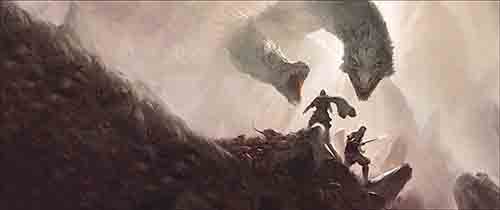The latest edition in Centipede Press’ series of Fritz Leiber’s classic sword and sorcery books arrived in the mail today. The cover is another gorgeous full-spread dust jacket, a painting of the two heroes facing a two-headed beast.

I haven’t yet had time to re-read the tales within this book, which also includes some bonus material. I do know that having read the seven books that collect the stories of Fafhrd and the Gray Mouser out of order and multiple times, that they shimmer and blend into one vast tale. So, I remember little to nothing of the stories in this book, or at least I won’t until I start to re-read them.
Part of this problem is that the books usually are comprised of multiple short stories, and these appear out of order in terms of the two characters’ lives. It’s not a simple linear tale, each book a novel identifiable through a specific plot (or, in many cases, a main plot and a few sub-plots). When it comes to other books, other series, even those I have read just once, I can with a fair degree of certainty remember the plot just by looking at the cover and title. Not so with Leiber’s books. It doesn’t mean they’re not memorable, at least as a whole.
Maybe that’s a good thing, for they can be re-read almost with the same degree of pleasure as upon the first reading. If the stories don’t always stand out, the two main characters certainly are unique. They are contrasts in style and stature. They embody different skills, though it’s not a case of one being the muscle and the other the brain, despite one big in size and the other small. They complement each other well in almost every aspect. I think of certain other fantasy fiction characters memorable from my limited reading in the same genre as Leiber’s books. Jack Vance’s Cugel the Clever worked alone, allying himself only briefly with others and then as part of his own goals. Nifft the Lean, Michael Shea’s rogue who owes much to Cugel, had lengthy partnerships with others of his profession, yet none that lasted as such like Leiber’s two men. No doubt there have been prior instances of similar situations, and more than a few imitators.
Nonetheless, I find myself excited to finally have the fifth book in hand. There’s one more book in the series of which I only have the paperback. The seventh I have as a mass market hardcover, yet to complete the collection I’ll likely be compelled to either replace that one, or keep both with the former a memento, a treasured item from back when great books were being written by those who remain giants in the field.